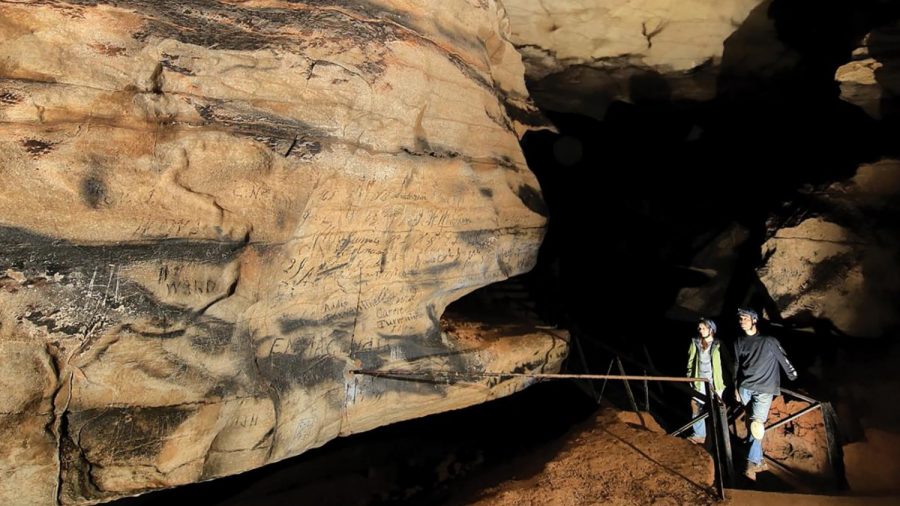A team of scholars translated Cherokee inscriptions on Alabama cave walls and determined some of them were written in the 19th century as a ceremonial part of stickball games.
A study published this month in the journal Antiquity provides English translations of these writings in the Cherokee syllabary, the written version of the Cherokee language pioneered by the scholar Sequoyah that was widely adopted by the Cherokee nation in 1825.
Stickball, a Cherokee game similar to lacrosse, pits two different communities against with each other over a period of days. Participants in the game engaged in purifying rituals involving sacred water deep in the cave before and after the game as well as in intermissions during the contest.
The Manitou caves, located about 80 miles southeast of Huntsville, Alabama, were open for tourism from 1888 to 1979, and walkways were built to facilitate public access, destroying some signs of the Cherokee’s earlier use of the caves. But the walls remained intact.
Jan Simek, a professor at the University of Tennessee who co-authored the study, told CNN that his colleague Alan Cressler, an “avocational caver,” was exploring a portion of the caves in 2006 and found inscriptions that were not in English.
He sent photos to Simek, who could tell the language was Cherokee. Simek said that scholars weren’t able to secure deeper access to look for more inscriptions until the caves changed ownership in 2015.
Simek has studied cave paintings in both the Old World and the New World, and says the discovery is important for a number of reasons.
First of All, They’re Cave Writings, Not Cave Paintings
The fact that these are actual writings is an important distinction, Simek said, as many cave paintings are thousands of years old and pre-date written language. They require scholars to make informed guesses about what they mean.
The cave writings revealed at Manitou, however, don’t require as much guesswork. They actually say what they mean.
For instance, one reads, “The leaders of the stickball team on the 30th day in their month April 1828.”
The “their” in that statement makes clear it’s a reference to the European calendar, and delivers a precise meaning beyond the broad themes found in prehistoric cave paintings. And they’re signed by an actual writer, Sequoyah’s son, Richard Guess, who led the players in the rituals.
The researchers believe another inscription, “We who are those that have blood come out of their nose and mouth,” refers to injuries incurred during the game, which, unlike modern lacrosse, was played without helmets or pads.
The Revelations Confirm What Scholars Have Believed About Cave Paintings in Other Contexts
Simek said scholars believe cave paintings around the world have special spiritual significance. These writings tell him that belief is correct.
One remarkable find was inscriptions written backwards on the cave ceiling. If the ceiling is viewed as a portal into the spirit world, then those lines would read normally for beings viewing them from the other side.
The scholars approximated the meaning of one backwards ceiling inscription as, “I am your grandson,” representing a way the Cherokee might have directly addressed ancestors.
Caves often functioned like churches for early peoples. “You can achieve altered states of consciousness in the darkness,” Simek said, adding that in underground springs, “Water also makes its initial appearance.”
“These were sacred spaces rather than ‘art galleries,’ ” the study says.
The Writings Spotlight the Cherokee During a Critical Era in Their History
The study was also notable because Euro-American archaeologists and scholars from Cherokee tribes collaborated.
Simek says the memories of indigenous peoples are often lost because “their histories are written by those who usurped them. We rarely have testimonies from the peoples themselves.”
Sequoyah had lived in nearby Willstown (modern-day Fort Payne, Alabama), a settlement founded by Cherokee refugees avoiding reprisals by the US federal government. Sequoyah, who also used the name George Guess, left for Arkansas, Simek said. But his son Richard Guess would have still have been in the area, as government records show. Those records would corroborate the Richard Guess signature found in the cave.
Another study co-author, Julie Reed, who is Cherokee, said the writings showcase the “intellectual capacity of the people I descend from. They were using a brand new technology to reinforce old ideas.”
The scholars declined to publish translations of some of the inscriptions because they depict sensitive spiritual rituals of the Cherokee people.
Reed said it was important for the meanings of the rituals to first be revealed to living Cherokee descendents in an appropriate way because the Cherokee nation has “intellectual sovereignty” over them.
The discovery is a “reminder of the voices we need to listen to, speaking in places where we wouldn’t dare to listen.”
![]()


